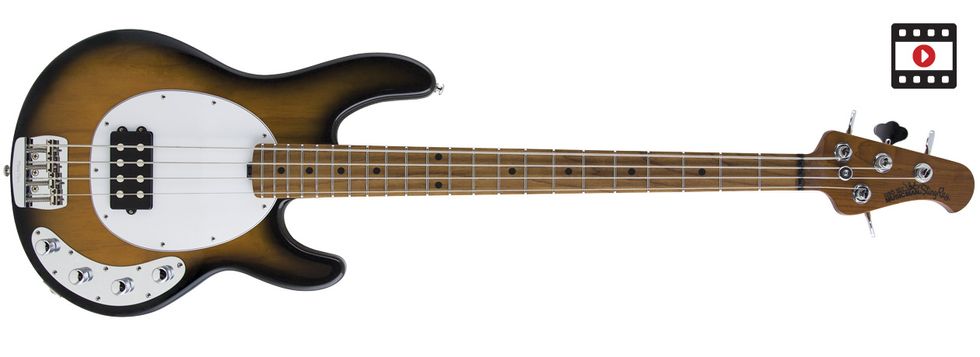
Clip 1 - Treble boost, mid boost.
Clip 2 - Treble boost, bass boost.
Clip 3 - Treble, bass, and mid dials dimed.
RatingsPros:Well engineered. Exciting new ground for an iconic bass. Cons: EQ could use a little frequency adjusting for the top end. Street: $1,999 Music Man StingRay Special music-man.com | Tones: Playability: Build/Design: Value: |
When the Music Man StingRay burst onto the scene in 1976, it brought with it a midrange attack that shifted the bass-universe curve rather abruptly. It was the disco era, so it may have been a perfect storm of players, style of music, and engineers that helped the StingRay soar, but I’d like to think the bass spoke for itself. We started hearing it cut through the mix from the likes of Louis Johnson, Tony Levin, and Flea, among countless others who used the sweet sonic punch of this model to craft signature tones.
Forty years is a long time, however, and with the many advances in technology, electronics, and instrument building, perhaps the engineers at Ernie Ball decided this would be the year to change the formula. The changes will be welcome for some, not for others, and the purists might possibly be left crying on their Michael Jackson albums. Or will they? That’s why we’re here: to give a proper once or twice over to Ernie Ball's re-imagined Music Man StingRay.
A Ray of Light
Before we go forward, we should always look back. The original StingRay, in all its glory, did have some issues. It was a heavy beast. It was sonically limited, and although the onboard active pre was a welcome breath for players, not having control over the mids did turn some away because of too much point in the tone.
So, what is a modern design team to do? When I opened the hardshell case, an audible “whoa” escaped my lips. My eyes didn’t know where to go first: the spectacular ’burst finish or the new roasted-maple neck. When I picked up the bass, my arms were greeted with a lighter instrument than I’m used to with my vintage models. It turns out the engineers managed to shave a full pound off the new incarnation of this bass, which weighs in at just a hair under 8 1/2 pounds.
The little design changes really make a difference on the StingRay Special. A die-hard follower will notice a difference, but to the first-time user, the bass will likely feel right at home. First, there is a belly scoop on the back and a rounded arm contour for added playing comfort, and it does its job well. Tuning up—and this may sound silly—felt slightly different as well. There are new lightweight, ergonomic Music Man tuners onboard, which means your fingers actually have something to grasp other than a thin slice of metal—again, subtle, but noticed. Some other changes include a 5-bolt neck design, a lighter bridge with a smaller footprint, and a compensated nut.
thunder and lightning.
Highs, Lows, and That Thing In-Between
So, we have all these new things to talk about, but at the heart of every instrument is its tone: the thing we should really be most concerned with. The company has made some changes to the StingRay’s electronics as well. First, the preamp system is now 18V, which is intended to provide longer battery life and more headroom. A 3-band EQ handles boost/cut for treble, mids, and bass. The redesigned humbucker on the StingRay Special features new neodymium magnets and the pole pieces have a new spacing layout to align perfectly under the strings. Again, small touches that amount to big things.
I plugged the StingRay into my trusty Eden CXC210 combo, which gives a very accurate sonic reflection without coloring tone. With the StingRay’s EQ set flat, the bass was, well, flat. It had mid point, but not much else. In other words, the bass needs the pre. I added a bit of top end and bass to give it some help, and that really did the trick. The StingRay started to give me more of what I wanted: thunder and lightning. The inevitable slap runs were exhilarating—with tight precision and a low-end attack like an anvil—and felt fantastic thanks to the silky-smooth, gunstock-oil-and-wax-finished neck.
The fingerstyle attack point was there as well, and it kept the bass where a StingRay should be—sitting in the mix just right. One thing I noticed that’s different from earlier models is that the treble control’s range won’t allow the tone to get super crispy, which can be good or bad, depending on the application. The top end is there, but I felt like the tone frequency needed to open up a hair more.
One great thing about the StingRay’s preamp is the ability to dime the controls and still have the bass sing. If you are a one-tone kind of player, this would be that tone—set for stun. All the great tone is there with punch, clarity, and low-end rumble, and all without being overbearing. The StingRay’s new incarnation was fine with a plectrum or my fingers, and had the same authoritative tone either way.
The Verdict
Being iconic is not easy—especially when it comes time for redesign. The Ernie Ball Music Man StingRay Special is both a mouthful and a handful. One side of me loves this bass for the redesign, the great new features, and the balanced, strong tone. My selfish side misses a little of the mass and the “nastier” EQ settings I could achieve with the older models. The new StingRay will likely soon be found in the hands of famous players and will inspire new generations of MM fans as well—of that I don’t doubt. I just hope they also get to play the original models and be reminded why they purchased the lighter and more versatile new incarnation.
Watch the Review Demo:







![Rig Rundown: AFI [2025]](https://www.premierguitar.com/media-library/youtube.jpg?id=62064741&width=1245&height=700&quality=70&coordinates=0%2C0%2C0%2C0)












 Shop Scott's Rig
Shop Scott's Rig

![Rig Rundown: Russian Circles’ Mike Sullivan [2025]](https://www.premierguitar.com/media-library/youtube.jpg?id=62303631&width=1245&height=700&quality=70&coordinates=0%2C0%2C0%2C0)













































